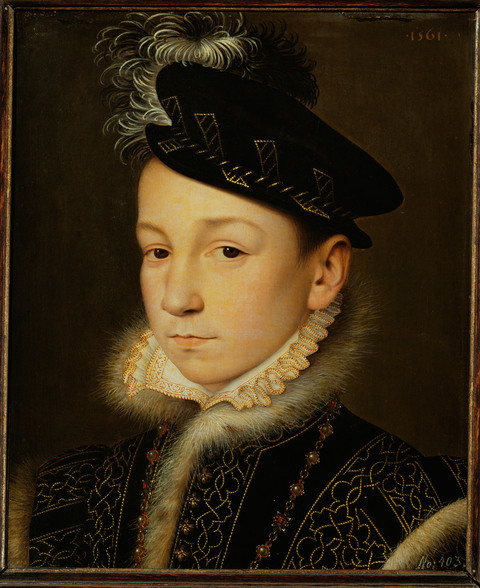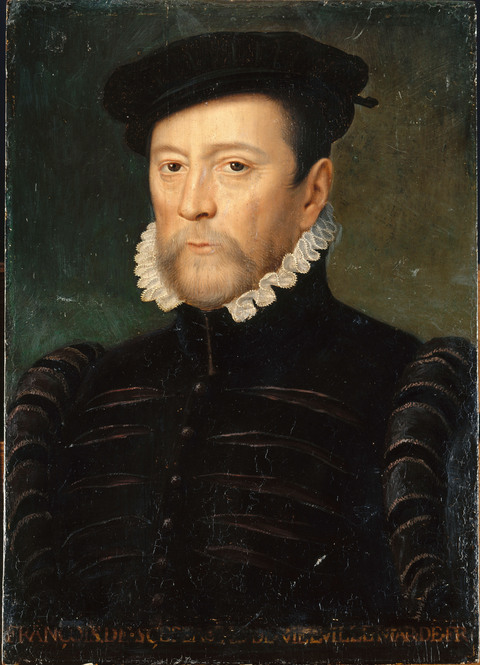Marks, Inscriptions, and Distinguishing Features
Dated in the upper-right corner: • 1566 •
Entry



Author
Provenance
By descent within the family of the sitter to Jean de Scépeaux.
(Newhouse Galleries, New York);16
G.H.A. Clowes, Indianapolis, in 1951;
The Clowes Fund, Indianapolis, from 1958–2004, and on long-term loan to the Indianapolis Museum of Art since 1971 (C10020);
Given to the Indianapolis Museum of Art, now the Indianapolis Museum of Art at Newfields, in 2004.
Exhibitions
John Herron Art Museum, Indianapolis, 1959, Paintings from the Collection of George Henry Alexander Clowes: A Memorial Exhibition, no. 14;
Art Gallery, University of Notre Dame, Notre Dame, IN, 1962, A Lenten Exhibition, no. 11;
Indiana University Art Museum, Bloomington, 1963, Northern European Painting: The Clowes Fund Collection, no. 6;
Taft Museum, Cincinnati, OH, 1977, Best of 50;
Indianapolis Museum of Art at Newfields, 2019, Life and Legacy: Portraits from the Clowes Collection;
Guangdong Museum, Guangzhou, China; Hunan Museum, Changsha, China; Chengdu Museum; 2020–2021, Rembrandt to Monet: 500 Years of European Painting.
References
Mark Roskill, “Clowes Collection Catalogue” (unpublished typed manuscript, IMA Clowes Archive, Indianapolis Museum of Art, Indianapolis, IN, 1968);
A. Ian Fraser, A Catalogue of the Clowes Collection (Indianapolis: Indianapolis Museum of Art, 1973), 142–143 (reproduced);
Anthony F. Jansen and A. Ian Fraser, 100 Masterpieces of Painting: Indianapolis Museum of Art (Indianapolis: Indianapolis Museum of Art, 1980), 56–57 (reproduced);
Kjell M. Wangensteen et al., Rembrandt to Monet: 500 Years of European Painting (Nanjing: Jiangsu Phoenix Literature and Art Publishing, 2020), 116–117 (reproduced).
Kjell M. Wangensteen et al., Floating Lights and Shadows: 500 Years of European Painting (Nanjing: Jiangsu Phoenix Literature and Art Publishing, 2020), 114–115 (reproduced).
Technical Notes and Condition
The uncradled panel consists of a single, radially cut oak plank of Baltic origin. It retains its original thickness of 1.2 cm in the center and beveling along the four edges. Dendrochronological analysis has found that the earliest heartwood ring was formed in 1517, providing its earliest possible date of creation as 1534. The panel was most likely prepared with a chalk ground layer common for Northern European panel paintings and a thin white priming layer of lead white likely bound in an oil-based medium. The underdrawing has been executed in a dry medium, outlining the contours and fringes of the collar, and using parallel hatching to indicate shaded areas. The absence of adjustments may indicate that a transfer method may have been used, although no marks of mechanical transfer have been identified on the drawing in the British Museum. The support and paint layers are in good condition. The painting has undergone previous treatment to compensate for minor losses. Its cracked varnish coating consists of multiple layers that have developed a craquelure over time and obstructs the visibility of the painted surface.
Notes
-
Proposed by Alexandra Zvereva, Portraits dessinés de la cour des Valois: Les Clouet de Catherine de Médicis (Paris: Arthena, 2011), 128. ↩︎
-
Alexandra Zvereva, Portraits dessinés de la cour des Valois: Les Clouet de Catherine de Médicis (Paris: Arthena, 2011), 129, 415 (Document 2.5). ↩︎
-
Alexandra Zvereva, Portraits dessinés de la cour des Valois: Les Clouet de Catherine de Médicis (Paris: Arthena, 2011), 130–131. She also proposes that the unusually rigid en face drawing of Francis I in red chalk (Chantilly, Musée Condé, inv. MN 4) could have been a study executed during the work on the king’s effigy. See Alexandra Zvereva, Portraits dessinés de la cour des Valois: Les Clouet de Catherine de Médicis (Paris: Arthena, 2011), 203, cat. no. 3. ↩︎
-
Cécile Scailliérez, s.v. “Clouet, François,” Allgemeines Künstlerlexikon (Munich: De Gruyter, 1998), extensively references the archival findings. ↩︎
-
Étienne Moreau-Nélaton, Le portrait en France à la cour des Valois: Crayons français conservés dans la collection de M. G. Salting à Londres (Paris: Libr. centrale des beaux-art, 1910), pl. XXVIII. ↩︎
-
Louis Dimier, Histoire de la peinture de portrait en France au XVIe siècle (Paris: van Oest, 1924–26), 2:133 and 143, no. 592. ↩︎
-
Chantilly, Musée Condé, MN 311. Dimier’s identification of his “Master of Luxembourg-Martigues” with Jean Duval in Louis Dimier, La peinture française au XVIe siècle (Marseilles: Éditions françaises d’art, 1942), 45. ↩︎
-
Cécile Scailliérez, s.v. “Duval, Jean,” Allgemeines Künstlerlexikon (Munich: De Gruyter, 2002). ↩︎
-
Alexandra Zvereva, Portraits dessinés de la cour des Valois: Les Clouet de Catherine de Médicis (Paris: Arthena, 2011), no. 351. ↩︎
-
Florence, Palazzo Pitti: a full-length portrait of about 1547 and a small bust-length portrait of 1559. ↩︎
-
See also the full-length portrait of King Charles IX, Vienna, Kunsthistorisches Museum, inv. 752, dated 1563 (originally 1569?). ↩︎
-
Paris, Musée du Louvre, inv. 3256. ↩︎
-
Louis Dimier, Histoire de la peinture de portrait en France au XVIe siècle (Paris: van Oest, 1924–1926), 2:147, no. 619. This portrait was in the collection of Roger de Gaignières. ↩︎
-
Chantilly, Musée Condé, inv. PE 590. See Albert Châtelet, François-Georges Pariset, and Raoul de Broglie, Chantilly–Musée Condé: Peintures de l’école française (Paris: Editions des musées nationaux, 1970), no. 21. ↩︎
-
Louis Dimier, Histoire de la peinture de portrait en France au XVIe siècle (Paris: van Oest, 1924–1926), 2:398, no. 1697 (Besançon) and no. 1698 (Aix-en-Provence). For the Besançon version, inv. 875.7.1, see Anne Dubois de Groër, Corneille de La Haye dit Corneille de Lyon (Paris: Arthena, 1996), 259–260, no. 216. ↩︎
-
Letters between G.H.A. Clowes and Bertram Newhouse indicate that the painting arrived in Indianapolis in spring 1951; Newhouse Correspondence, Clowes Registration Archive, Indianapolis Museum of Art at Newfields. ↩︎
